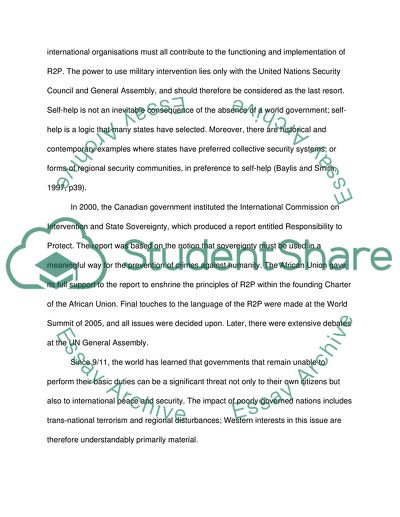Cite this document
(Responsibility to Protect (R2P) Is a New and Potent Weapon Term Paper, n.d.)
Responsibility to Protect (R2P) Is a New and Potent Weapon Term Paper. Retrieved from https://studentshare.org/law/1742256-responsibility-to-protect-r2p-is-a-new-and-potent-weapon-in-the-arsenal-of-global-civil-societys-struggles-to-overcome-both-domestic-and-external-aggression-under-the-guise-of-new-humanitarianism-discuss
Responsibility to Protect (R2P) Is a New and Potent Weapon Term Paper. Retrieved from https://studentshare.org/law/1742256-responsibility-to-protect-r2p-is-a-new-and-potent-weapon-in-the-arsenal-of-global-civil-societys-struggles-to-overcome-both-domestic-and-external-aggression-under-the-guise-of-new-humanitarianism-discuss
(Responsibility to Protect (R2P) Is a New and Potent Weapon Term Paper)
Responsibility to Protect (R2P) Is a New and Potent Weapon Term Paper. https://studentshare.org/law/1742256-responsibility-to-protect-r2p-is-a-new-and-potent-weapon-in-the-arsenal-of-global-civil-societys-struggles-to-overcome-both-domestic-and-external-aggression-under-the-guise-of-new-humanitarianism-discuss.
Responsibility to Protect (R2P) Is a New and Potent Weapon Term Paper. https://studentshare.org/law/1742256-responsibility-to-protect-r2p-is-a-new-and-potent-weapon-in-the-arsenal-of-global-civil-societys-struggles-to-overcome-both-domestic-and-external-aggression-under-the-guise-of-new-humanitarianism-discuss.
“Responsibility to Protect (R2P) Is a New and Potent Weapon Term Paper”, n.d. https://studentshare.org/law/1742256-responsibility-to-protect-r2p-is-a-new-and-potent-weapon-in-the-arsenal-of-global-civil-societys-struggles-to-overcome-both-domestic-and-external-aggression-under-the-guise-of-new-humanitarianism-discuss.


